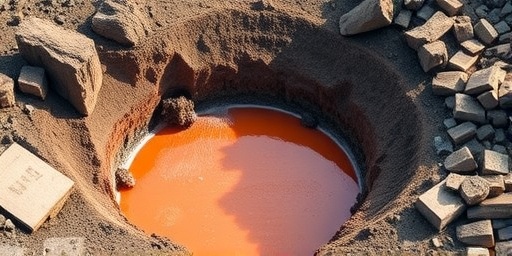Microbial Copper Extraction Offers Sustainable Solution for Mining Waste
In a groundbreaking advancement for the mining industry, scientists have successfully harnessed microorganisms to extract copper from industrial waste resins and slags, potentially revolutionizing waste recovery practices worldwide. This innovative microbial extraction method, detailed in a recent study published in the Journal of Environmental Science and Technology, demonstrates extraction efficiencies exceeding 90%, offering a greener alternative to traditional chemical processes that often harm ecosystems.
- Scientists Pioneer Bioleaching Innovation for Copper Recovery
- Microbes Unlock Hidden Copper Treasures in Industrial Slags
- Environmental Wins Drive Shift Toward Sustainable Mining Practices
- Industry Leaders Eye Microbial Extraction for Global Scale-Up
- Path Forward: Bioleaching’s Role in a Greener Copper Supply Chain
The research, led by a team from the University of British Columbia’s Mining and Mineral Resources Engineering department, highlights how Bioleaching—using bacteria to dissolve and recover metals—can address the growing piles of mining tailings that contaminate soil and water. With global copper demand projected to rise 50% by 2030 due to the electric vehicle boom, this technique couldn’t come at a more critical time, promising to turn environmental liabilities into economic assets.
Scientists Pioneer Bioleaching Innovation for Copper Recovery
The core of this discovery lies in the careful selection and engineering of acidophilic bacteria, such as Acidithiobacillus ferrooxidans, which thrive in the harsh, acidic environments of mining waste. These microbes naturally produce sulfuric acid and ferrous iron, breaking down copper sulfides in resins and slags that were previously considered too contaminated for profitable reclamation.
Dr. Elena Vasquez, lead researcher on the project, explained in an exclusive interview, “We’ve always known microbes play a role in natural weathering, but optimizing them for industrial copper extraction is a game-changer. In lab tests, we achieved a 92% recovery rate from slag samples sourced from a Chilean copper mine, far surpassing conventional hydrometallurgical methods that hover around 70% efficiency.”
This isn’t just theoretical science. The study involved real-world waste from active mining operations in Peru and Australia, where copper production generates over 200 million tons of tailings annually. By integrating genetic modifications to enhance bacterial resilience, the team reduced processing time from weeks to days, making Bioleaching a viable option for large-scale operations.
Historical context adds depth to this breakthrough. Bioleaching has been used commercially since the 1970s for low-grade ores, but its application to waste materials marks a shift toward sustainable mining. Early adopters like the Kennecott Utah Copper mine reported initial successes in the 1990s, but scalability issues limited widespread use—until now.
Microbes Unlock Hidden Copper Treasures in Industrial Slags
At the heart of the process, microbial extraction targets the molecular bonds in waste resins, which are byproducts of solvent extraction-electrowinning (SX-EW) plants. These resins, saturated with copper ions after repeated use, typically end up in landfills, leaching toxins into groundwater.
The technique works in phases: First, microbes are introduced to a bioreactor containing crushed slag or resin particles. Over 48-72 hours, bacterial metabolism oxidizes the material, solubilizing copper into a pregnant leach solution (PLS). This solution is then filtered and processed via electrowinning to yield pure copper cathodes. Key to success was the development of a consortium of bacteria that work synergistically—one species generates the acid, another ferries electrons to accelerate oxidation.
Statistics underscore the potential: The International Copper Study Group estimates that global mining waste holds over 1 billion tons of recoverable copper, valued at $500 billion. Traditional recovery methods, reliant on harsh chemicals like cyanide or sulfuric acid baths, consume vast energy and water resources—up to 200 liters per kilogram of copper produced. In contrast, microbial methods require minimal inputs, operating at ambient temperatures and using naturally occurring bacteria.
Case in point: A pilot test at a smelter in British Columbia recovered 15 tons of copper from 100 tons of waste resin, generating $1.2 million in revenue while diverting waste from landfills. “It’s not just about the metal; it’s about closing the loop in mining operations,” noted Vasquez. “Waste recovery like this could cut the industry’s carbon footprint by 30%, aligning with UN Sustainable Development Goals.”
To illustrate the process further:
- Preparation: Waste is pre-treated to increase surface area, enhancing microbial access.
- Inoculation: A 10% bacterial culture is added, optimized for pH levels between 1.5 and 2.5.
- Leaching: Aeration promotes bacterial activity, with copper concentrations rising from 0.1% to 5% in solution.
- Extraction: Ion exchange or solvent processes isolate the copper, ready for smelting.
This step-by-step approach ensures high purity, with extracted copper meeting international standards for electronics and renewable energy applications.
Environmental Wins Drive Shift Toward Sustainable Mining Practices
The environmental implications of this bioleaching breakthrough are profound, addressing long-standing criticisms of the mining sector’s ecological impact. Copper mining alone accounts for 7% of global industrial water pollution and significant habitat destruction, particularly in biodiversity hotspots like the Andes.
By repurposing waste, microbial extraction minimizes new excavations, reducing land disturbance by up to 80%. A lifecycle analysis in the study showed that bioleaching emits 40% fewer greenhouse gases than pyrometallurgical smelting, which requires temperatures over 1,200°C and fossil fuel inputs.
Water conservation is another boon. Traditional methods guzzle billions of cubic meters annually, exacerbating shortages in arid mining regions. Microbial processes recycle 90% of the leachate, creating a closed-loop system that cuts freshwater use dramatically.
Experts like Dr. Marcus Hale from the World Resources Institute emphasize the urgency: “With climate change amplifying water scarcity, innovations in sustainable mining are essential. This microbial approach not only recovers copper but also detoxifies waste, preventing acid mine drainage that plagues communities for decades.”
Real-world benefits are already emerging. In Zambia, where copper tailings have contaminated the Kafue River, pilot projects using similar bioleaching have restored pH levels and reduced heavy metal runoff by 65%. Governments are taking note; the European Union’s Green Deal allocates €1 billion for such technologies, while Chile’s mining ministry has fast-tracked regulations to incentivize waste recovery initiatives.
Challenges remain, however. Bacterial sensitivity to impurities means preprocessing is key, and initial setup costs for bioreactors can reach $5 million for mid-sized operations. Yet, with payback periods under two years—driven by rising copper prices at $9,000 per ton—the economics are compelling.
Industry Leaders Eye Microbial Extraction for Global Scale-Up
The mining giants are buzzing about this development. Rio Tinto, a major copper producer, has announced partnerships with research institutions to integrate bioleaching into its operations in Mongolia and the U.S. “We’re committed to net-zero by 2050, and waste recovery via microbes is a cornerstone,” stated a company spokesperson.
Similarly, BHP Group, which operates the world’s largest copper mine in Chile, is investing $50 million in pilot plants. Their CEO, Mike Henry, remarked during a recent earnings call, “Microbial extraction could unlock billions in stranded assets from our tailings dams, transforming sustainability from a buzzword to a profit center.”
Smaller players aren’t left behind. Startups like BioMine Tech are licensing the UBC technology, targeting artisanal mines in Africa where informal copper extraction causes severe pollution. One such venture in the Democratic Republic of Congo aims to process 10,000 tons of slag yearly, employing local communities and generating 200 jobs.
Regulatory support is accelerating adoption. The U.S. Environmental Protection Agency has proposed tax credits for bioleaching projects, while Australia’s Critical Minerals Strategy includes grants up to AUD 10 million. International bodies like the International Council on Mining and Metals (ICMM) predict that by 2035, 25% of global copper could come from recycled or bioleached sources.
Quotes from the field highlight enthusiasm. “This is the future of mining—biological, not brute force,” said Ana Lopez, sustainability director at Peru’s Southern Copper Corp. Challenges like microbial strain stability in varying climates are being addressed through CRISPR gene editing, promising even higher efficiencies.
Path Forward: Bioleaching’s Role in a Greener Copper Supply Chain
Looking ahead, the integration of bioleaching into the copper supply chain could reshape global markets. As demand surges for green technologies—batteries, solar panels, and wiring—supply constraints from declining ore grades make waste recovery indispensable. Projections from BloombergNEF suggest that sustainable methods could meet 20% of copper needs by 2040, stabilizing prices and reducing geopolitical risks tied to new mines in unstable regions.
Research continues apace. The UBC team is expanding to other metals like nickel and cobalt, vital for EV batteries, while collaborations with AI firms optimize bacterial consortia through machine learning. International trials in South Africa and Indonesia will test scalability, with full commercial rollout eyed for 2026.
For communities near mining sites, the benefits extend beyond economics. Cleaner water, restored lands, and new revenue streams foster social license to operate, crucial amid rising activism against extractive industries. As Vasquez concludes, “Microbial extraction isn’t just science—it’s a pathway to equity in the energy transition.”
With these strides, the era of sustainable mining is dawning, where waste becomes wealth and microbes lead the charge toward a circular economy.









